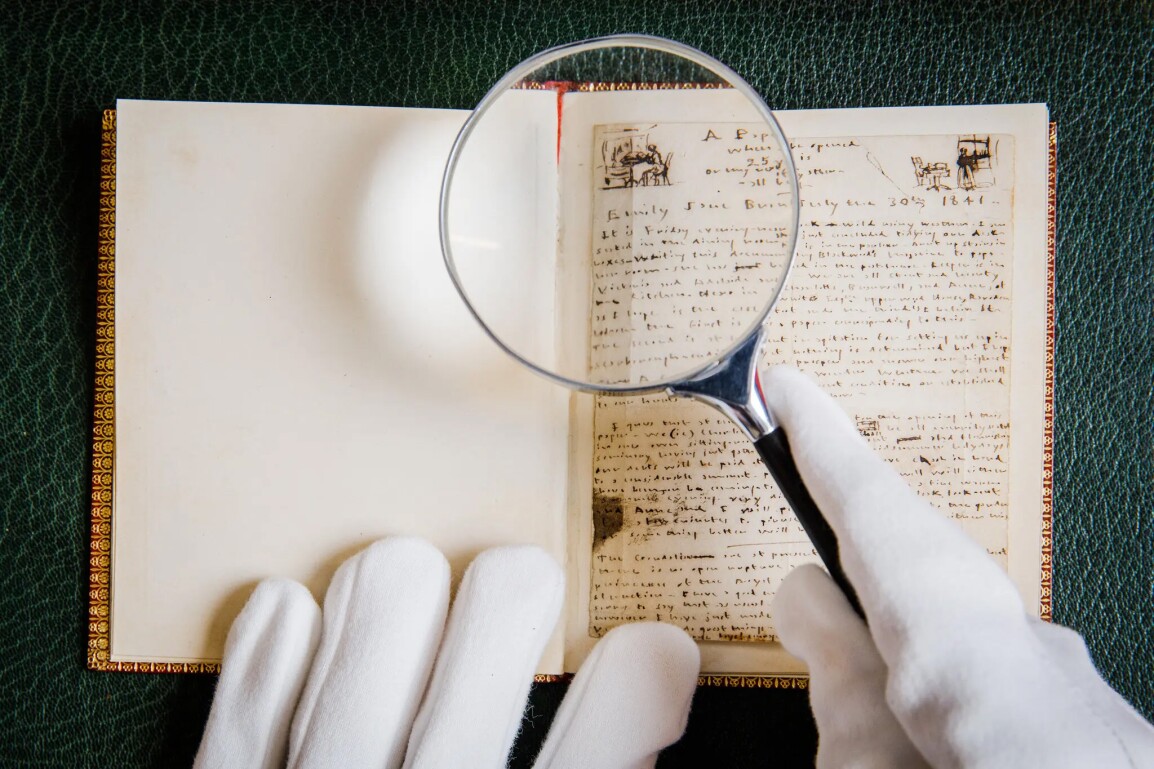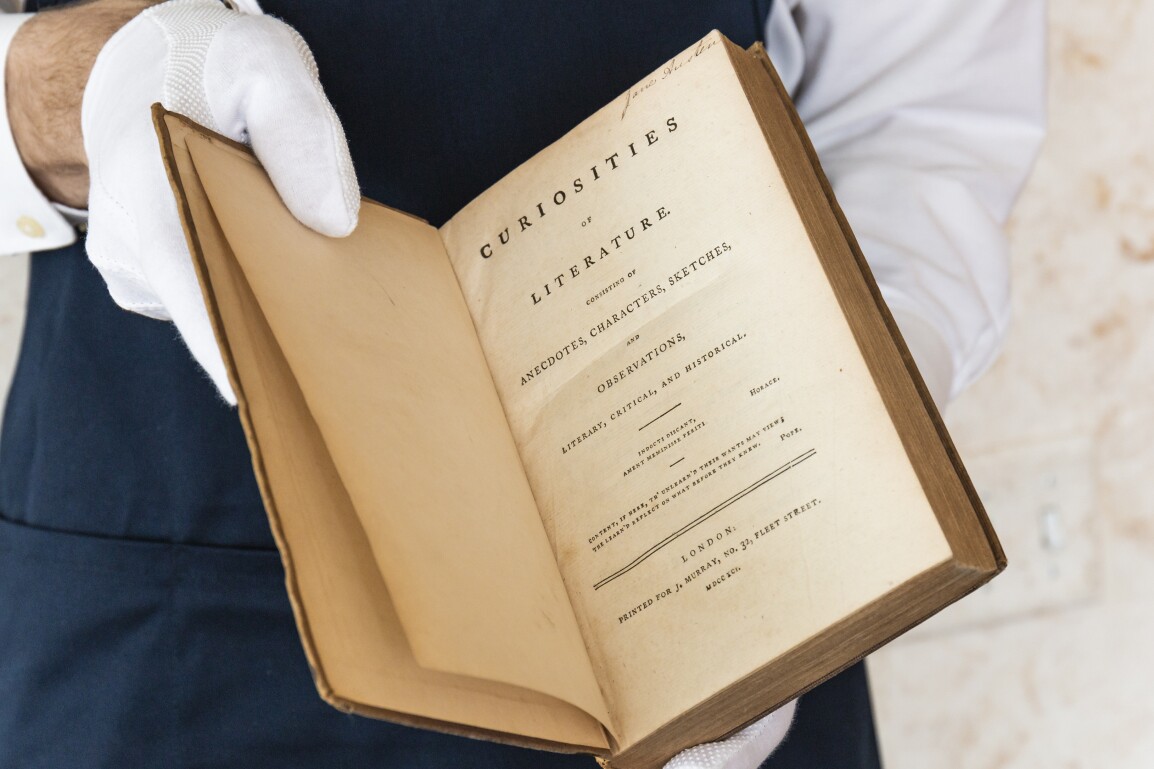I n late 2023, a rare book associated with Jane Austen unexpectedly went up on the auction block at Sotheby’s. The book in question wasn’t one of Austen’s novels – it was a copy of Curiosities of Literature, first published by Isaac D’Israeli in 1791, owned and cherished by Austen herself. A self-taught writer and a dedicated reader, Austen underlined several passages in her copy of “anecdotes, characters, sketches and observations, literary, critical, and historical,” as Curiosities’ first page indicates. This literary history helped propel an otherwise ordinary volume far above expectations, ultimately selling for $215,900 (above a $100,000-150,000 estimate).
Curiosities’ success followed the 2021 appearance of a vast collection featuring significant works by numerous women authors of the period. Throughout their lifetimes, William and Alfred Law – two brothers and prosperous mill owners during the Victorian era – assembled an enviable trove of first-edition 19th-century literature and manuscript material known as the Honresfield Library. When the Law brothers’ collection went up for auction – including the likes of manuscripts by Austen, the Brontë sisters, Robert Burns and Walter Scott – a group of museums and libraries raised £15 million collectively to buy these treasures from Sotheby’s to be held in public institutions, such as the Bodleian, in Oxford, and the National Library of Scotland. The rarity of the printed works and manuscripts, coupled with their provenance and their excellent condition, all contributed to the cultural fascination surrounding these 19th-century literary gems.
The appetite for such fine material by women authors has not waned. Curiosities of Literature, offered in 2023, was from an important American collection that also boasted scarce works by George Eliot, first editions of the Brontë sister’s novels and first editions of Jane Austen’s six novels, all of which were highly desirable on the market. ”Several of the copies were in the original publishers’ boards,” says Dr Kalika Sands, Sotheby’s international books specialist, referring to the way books were typically bound in the 18th and early 19th centuries. “They were meant to be ephemeral, because you would have them rebound in a style to match your own library.”

The Honresfield Library saw “absolute focus and excitement on the literature by women authors in particular.”
But what Sands found most striking during the auction was the “absolute focus and excitement on the literature by women authors in particular,” part of a growing interest she’s noticed among Sotheby’s collectors and consignors. The rising popularity of 19th-century literature confirms a preexisting fascination with Victorian-era storytelling – from women’s vantage points – that’s long been coalescing in the cultural consciousness. In recent years, a steady drip of film and television adaptations of these novels, coupled with a persistent critical and academic reevaluation of works written by the Brontës, Austen, George Eliot and Louisa May Alcott, among other authors who wrote inventive literature throughout the 1800s, is bolstering the market for works of 19th-century literature written by women. It also coincides with a larger trend that sees a shift away from a completist mindset, in favor of collectors who instead go after treasures they feel a genuine connection with.
While pursuing her DPhil (PhD) studies at the University of Oxford, where she focused on 19th-century British literature and how it was entwined with the history of science and medicine, Dr Sands found herself consistently moved by how modern these centuries-old texts by women authors were. Charlotte Brontë, for one thing, made her interest in both the Arctic and sanitary science plain in Jane Eyre – long before the term climate change was coined, as Sands notes. While Jane Austen sometimes received flak from critics for seemingly breezy novels about polite conversation, and the wealthy’s dramas playing out amid their louche living rooms, she had a gift for pulling at complex social, cultural and political threads hovering beneath the surface. Sense and Sensibility probes complex legal issues, for instance, and themes of colonialism and race are prevalent in Mansfield Park, although the novel stops short of fully embracing abolitionist politics – a movement to which Austen was likely sympathetic.
“When you start to pick apart her six novels, each one is doing something incredibly dynamic and often cutting,” Sands says. “That results in remarkably witty literature that transcends the intervening centuries. She had such a fantastic eye and was such a great observer of human behavior and character. That’s why we end up with so many Austen adaptations, whether it’s film or books or stage plays.”

Buzzy Hollywood adaptations of Austen and Brontë stories aren’t solely responsible for the resurgence of interest in 19th-century literature, yet these silver-screen releases undoubtedly have helped these authors’ works find new audiences – which inevitably spark new interpretations as a result. In a serendipitous twist, the Ang Lee-directed Sense and Sensibility adaptation was released in 1995, the same year that BBC’s Pride and Prejudice TV miniseries, starring Colin Firth in a now-iconic role as Mr Darcy, saw its premiere. The two adaptations became cultural moments unto themselves and reignited an interest in Austen’s novels, which crept up on bestseller lists again that year. It wasn’t just Austen’s work that ignited interest from Hollywood around then; in 1994, BBC released a miniseries about Eliot’s Middlemarch.
In Sands’ view, popular film and television adaptations of these novels aren’t demonstrably driving a bigger market for rare books by 19th-century women authors. Rather, popular versions, such as the 2005 film of Pride and Prejudice (starring Keira Knightley and Matthew Macfadyen), serve to complement the way stories by the likes of the Brontës, Austen and Louisa May Alcott have been recontextualized at the academic level for decades now.
Even more radical takes, such as Greta Gerwig’s adaptation of Little Women released in 2019, are reflective of shifting modes of thinking about authorship in relation to text. This might also explain why Sotheby’s sale of Austen’s Curiosities of Literature copy caused such a stir – and why the formative texts that shaped the minds of authors like George Eliot increasingly intrigue collectors. “The ways in which Gerwig’s Little Women adaptation deviated from the book were actually much closer to Louisa May Alcott’s life,” Sands says. “So I wonder, too, if elements of biography are coming into play along with the discipline of life writing, since it’s now become more popular and more of an accepted academic discipline.”





















